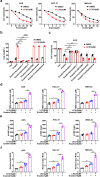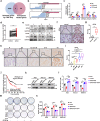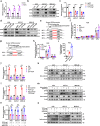Wnt/beta-catenin signaling confers ferroptosis resistance by targeting GPX4 in gastric cancer
- PMID: 35534546
- PMCID: PMC9613693
- DOI: 10.1038/s41418-022-01008-w
Wnt/beta-catenin signaling confers ferroptosis resistance by targeting GPX4 in gastric cancer
Abstract
The development of chemotherapy resistance is the most vital obstacle to clinical efficacy in gastric cancer (GC). The dysregulation of the Wnt/beta-catenin signaling pathway is critically associated with GC development and chemotherapy resistance. Ferroptosis is a form of regulated cell death, induced by an iron-dependent accumulation of lipid peroxides during chemotherapy. However, whether the Wnt/beta-catenin signaling directly controls resistance to cell death, remains unclear. Here, we show that the activation of the Wnt/beta-catenin signaling attenuates cellular lipid ROS production and subsequently inhibits ferroptosis in GC cells. The beta-catenin/TCF4 transcription complex directly binds to the promoter region of GPX4 and induces its expression, resulting in the suppression of ferroptotic cell death. Concordantly, TCF4 deficiency promotes cisplatin-induced ferroptosis in vitro and in vivo. Thus, we demonstrate that the aberrant activation of the Wnt/beta-catenin signaling confers ferroptosis resistance and suggests a potential therapeutic strategy to enhance chemo-sensitivity for advanced GC patients.
© 2022. The Author(s).
Conflict of interest statement
The authors declare no competing interests.
Figures







Similar articles
-
Asiaticoside promoted ferroptosis and suppressed immune escape in gastric cancer cells by downregulating the Wnt/β-catenin pathway.Int Immunopharmacol. 2024 Jun 15;134:112175. doi: 10.1016/j.intimp.2024.112175. Epub 2024 May 10. Int Immunopharmacol. 2024. PMID: 38733821
-
Fusobacterium nucleatum induces oxaliplatin resistance by inhibiting ferroptosis through E-cadherin/β-catenin/GPX4 axis in colorectal cancer.Free Radic Biol Med. 2024 Aug 1;220:125-138. doi: 10.1016/j.freeradbiomed.2024.04.226. Epub 2024 Apr 22. Free Radic Biol Med. 2024. PMID: 38657754
-
Wnt/β-catenin signaling inhibits oxidative stress-induced ferroptosis to improve interstitial cystitis/bladder pain syndrome by reducing NF-κB.Biochim Biophys Acta Mol Cell Res. 2024 Oct;1871(7):119766. doi: 10.1016/j.bbamcr.2024.119766. Epub 2024 May 31. Biochim Biophys Acta Mol Cell Res. 2024. PMID: 38823528
-
Targeting GPX4 in human cancer: Implications of ferroptosis induction for tackling cancer resilience.Cancer Lett. 2023 Apr 10;559:216119. doi: 10.1016/j.canlet.2023.216119. Epub 2023 Mar 8. Cancer Lett. 2023. PMID: 36893895 Review.
-
Exploring the molecular interactions between ferroptosis and the Wnt/β-catenin signaling pathway: Implications for cancer and disease therapy.Crit Rev Oncol Hematol. 2025 Jun;210:104674. doi: 10.1016/j.critrevonc.2025.104674. Epub 2025 Feb 24. Crit Rev Oncol Hematol. 2025. PMID: 40010619 Review.
Cited by
-
Investigation on the mechanism of the combination of eremias multiocellata and cisplatin in reducing chemoresistance of gastric cancer based on in vitro and in vivo experiments.Aging (Albany NY). 2024 Feb 9;16(4):3386-3403. doi: 10.18632/aging.205540. Epub 2024 Feb 9. Aging (Albany NY). 2024. PMID: 38345573 Free PMC article.
-
TRIB3 promotes malignancy of head and neck squamous cell carcinoma via inhibiting ferroptosis.Cell Death Dis. 2024 Mar 1;15(3):178. doi: 10.1038/s41419-024-06472-5. Cell Death Dis. 2024. PMID: 38429254 Free PMC article.
-
Helicobacter pylori induces GBA1 demethylation to inhibit ferroptosis in gastric cancer.Mol Cell Biochem. 2025 Mar;480(3):1845-1863. doi: 10.1007/s11010-024-05105-x. Epub 2024 Sep 16. Mol Cell Biochem. 2025. PMID: 39283563
-
TCF7L2 regulates GPX4 to resist ferroptosis and enhance osteogenesis in mouse mesenchymal stem cells.Eur J Med Res. 2025 Aug 5;30(1):713. doi: 10.1186/s40001-025-02993-7. Eur J Med Res. 2025. PMID: 40764595 Free PMC article.
-
Therapeutic effects of natural compounds against diabetic complications via targeted modulation of ferroptosis.Front Pharmacol. 2024 Sep 18;15:1425955. doi: 10.3389/fphar.2024.1425955. eCollection 2024. Front Pharmacol. 2024. PMID: 39359249 Free PMC article. Review.
References
-
- Pan KF, Zhang L, Gerhard M, Ma JL, Liu WD, Ulm K, et al. A large randomised controlled intervention trial to prevent gastric cancer by eradication of Helicobacter pylori in Linqu County, China: baseline results and factors affecting the eradication. Gut. 2016;65:9–18. doi: 10.1136/gutjnl-2015-309197. - DOI - PubMed
Publication types
MeSH terms
Substances
LinkOut - more resources
Full Text Sources
Medical
Miscellaneous

